ISSN ONLINE(2278-8875) PRINT (2320-3765)
ISSN ONLINE(2278-8875) PRINT (2320-3765)
Rashmi Jain1 Bhawana Goel2
|
| Related article at Pubmed, Scholar Google |
Visit for more related articles at International Journal of Advanced Research in Electrical, Electronics and Instrumentation Engineering
Prediction of solar radiation is done by Artificial Neural Network (ANN) fitting tool. For training and testing the ANN solar radiation data of different cities with different climatic conditions are used. The analysis used is Levenberg-Marquard (LM) algorithm. The ANN model results are compared with measured data on the basis of root mean square error (RMSE) and mean bias error (MBE). For Indian region, it is found that RMSE in the ANN model varies 0.0486–3.562. For the study, a multilayer feed forward (MLFF) neural network based on back propagation algorithm was developed, trained, and tested to predict global solar radiation for different cities of India. As the input parameters various geographical, solar and meteorological parameters of different locations with diverse climatic conditions were used. The main objective of this study is to review Artificial Neural Network (ANN) based techniques to identify suitable methods available in the literature for solar radiation prediction and to identify research gaps. The study shows that ANN techniques predict solar radiation more accurately in comparison to other (conventional) methods. We will found that the prediction accuracy of ANN models is dependent on input parameter combinations, training algorithm and architecture configurations.
Keywords |
| Artificial neural network, back propagation,global radiation,multilayer perceptron network, India |
INTRODUCTION |
| One of the most important challenges faced by many countries is Energy crisis. In today energy crisis scenario, solar energy plays a vital role as a renewable energy due to its unpolluted nature and abundance availability in tropical countries like India. It is necessary to have an accurate knowledge of the various components of solar energy available at the locations of our interest for its effective and efficient utilization. These components of solar energy are sunshine duration, maximum ambient temperature, latitude, longitude, relative humidity, day of the year, daily clear sky global radiation, total cloud cover, temperature, clearness index, altitude, months, average temperature, average cloudiness, average wind velocity, atmospheric pressure,extra -terrestrial radiation,evaporation,reference clearness index, mean diffuse radiation, mean beam radiation ,month, soil temperature. Out of these, global radiation is the most important component of solar radiation as it gives the total solar availability at a given place. It is measured only at a few locations because of the high cost involved in the purchase of various equipments and maintenance thereof. Mathematical models become inevitable for places where measurement of global radiation is not done in view of the some factors. A number of empirical models have been developed by using meteorological parameters such as sunshine hours, temperature, etc., in order to estimate global radiation. |
| The main objective of our this paper is to develop a computationally simpler ANN model to estimate global radiation with mean absolute percentage error of less than 5% using commonly measured weather parameters for places in India. Solar parameters such as solar declination, sunrise hour angle, extraterrestrial radiation and maximum possible sunshine duration (day length) have been used as inputs together with some geographical and meteorological parameters. The inputs used in this paper are freely available in all meteorological stations. In the present study, a multilayer feed forward neural network based on the Levenberg-Marquard (LM) back propagation learning algorithm was developed, trained and tested using the geographical, solar and meteorological parameters of various locations of India with varying climatic conditions. |
ANN MODEL |
| ‘Artificial neurons’ have seen as one type of nodes. These are called artificial neural networks (ANNs).The computational model inspired in the natural neurons is an Artificial Neuron. Natural neurons received the signals through synapses which are located either on the dendrites or membrane of the neuron.The signals which are received, if are strong enough (surpass a certain threshold), the neuron is activated and emits a signal though the axon. Then this signal might be sent to another synapse, and might activate other neurons.A simple neuron is shown in Figure1.[1] |
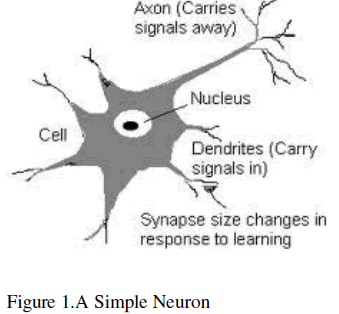 |
| Neurons is the core unit of an artificial neural network which uses a transfer function to develop output. The each and every input is multiplied by a weight , which serves as the connection between an input and the neuron and between the various layers of neurons. After that, the weight inputs are combined, after which the bias is added to the sum of the weighted inputs.The output is obtained when the neuron applies a transfer function to this result.A basic Artificial Neuron is shown in Figure 2.[1] |
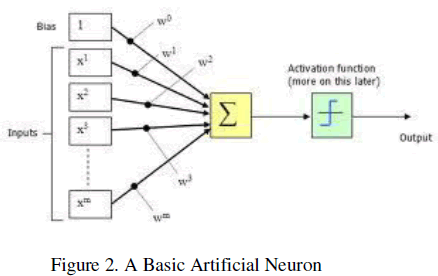 |
| Artificial neural networks matches with the biologicalneural networks. ANN models are used for various applications like pattern recognition,pattern classification, non-linear mapping, prediction and simulation. A multilayer perceptron (MLP) network have been used among various types of networks. |
| The neural network is a massively parallel-distributed processor which has the capability for storing experiential knowledge.It makes it available for different use. |
| Neural Network works like human brain in two ways. |
| 1.The network which is obtained from the learning process acquire the knowledge. |
| 2.Inter-neuron connection strengths which are known as synaptic weights are used to store the knowledge. |
| Artificial Neural Network has the ability to handle large and complex systems with many inter-related parameters. .It ignores unimportant large data and concentrates on the more important inputs and parameters.The back propagation is the most popular and powerful learning algorithm in neural networks. Back Propagation algorithm is worked on the error-correction learning rule. The error back-propagation process contains both the forward pass and the backward pass.Input vectors are applied to the input layer of the network in the forward pass and its effect propagates through the network through connection weights and layer by layer. At last, the group of outputs is developed as the actual response of the network. In the forward pass, the synaptic weights of the network are fixed whereas in the backward pass, the synaptic weights of the network are all adjusted in accordance with the error-correction rule.An error signal is produced when the actual response of the network is subtracted from the desired response. Then the error signal is propagated backward through the network. |
| The network consists of an input layer, an output layer and either one or more hidden layers. The architecture used in this case study, has an input layer which contains four inputs, one hidden layer with the Tan-Sigmoid activation function.A linear activation function ‘PURELIN’ is used for the output layer.For the implementation, the MATLAB Neural Network Fitting Toolbox (nftool), is used. For the training of network , the algorithm TRAINLM is used. |
METHODOLOGY |
| In the present case study, 4 Indian locations, Mumbai , Chandigarh, Nagpur, New Delhi, are selected [Table 1]. The measured meteorological data by Indian Meteorological Department (IMD), are mean duration sunshine per hour, height above sea level for these stations, are used. |
| Four neurons in the input layer correspond to the following input parameters with units in parentheses: |
| 1.. Latitude (deg) |
| 2.. Longitude (deg) |
| 3. Height above sea level (m) |
| 4. .Sunshine hours. |
| The ANN architecture is shown in Figure 3.[1] |
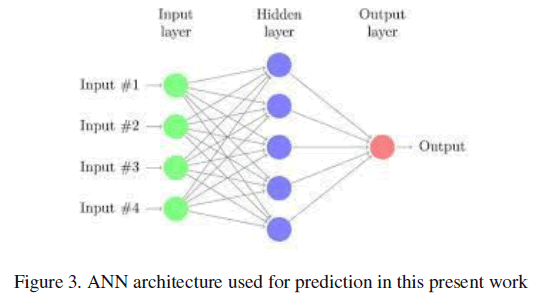 |
| By using neural network fitting (nftool) toolbox of MATLAB 2007software, Multi-layer Perceptron(MLP) neural networks are used.The geographical and sunshine hour data for cities Mumbai, Chandigarh, are used for training data and the geographical and sunshine hour data for cities Nagpur, New Delhi , are used for testing. |
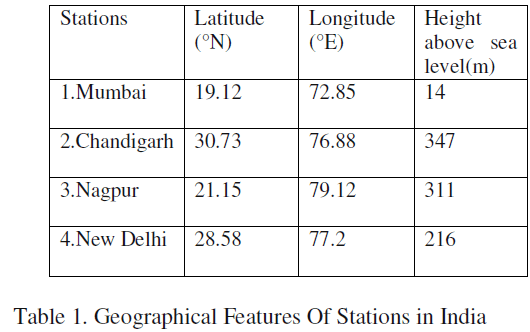 |
| The performance of the developed model has been studied and evaluated based on the well established statistical error parameters : |
| A. Mean Bias Error (MBE) is defined as: |
| where, K is the total number of observations, and are the ith observed value and ith calculated value of global radiation. |
| B. Root Mean Square Error (RMSE) is defined as: |
| C.Mean Absolute Percentage Error (MAPE) is defined as: |
| The test of Mean Bias Error (MBE) gives information on the long term performance of the models.The average amount of overestimation in the predicted values is given by the positive MBE and the average amount of underestimation in the predicted values is given by the negative MBE. The major drawback of the test(MBE) is that overestimation in one observation will cancel the underestimation in another observation. The mean Absolute Percentage Error (MAPE) ignores the error cancellation problem. The test parameter (MAPE) is not recommended from the analytical point of view because the absolute value of error is not a differentiable quantity. The test on Root Mean Square Error (RMSE) gives information on the short term performance of the models. It allows the term by term comparison of the actual deviation between the calculated and the measured values. RMSE is always positive. |
RESULTS AND DISCUSSIONS |
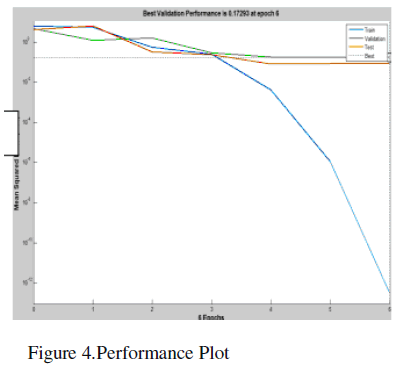 |
| The performance plot is shown in Figure 4. In this figure, by increasing the number of epoch, the mean squared error have become small.Both the test set error and the validation set error have same characteristics and no significant over fitting has occurred by epoch (where best validation performance has occurred). |
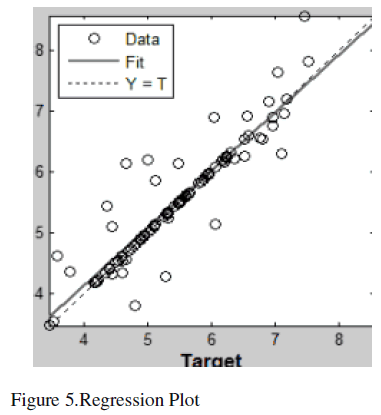 |
| The regression (R value ) between the outputs and targets is the measure of how well the variation in the outputs is described by the targets. The intercept(b) and slope (m) values in Figure 5 are 0.33, 0.96 respectively which predicts that the fit is good. The R-value is 91.96 % for the total response as shown in Figure 5. |
| The predicted solar radiation values are close to the actual values for all months. A small deviation is observed for the calculated values. |
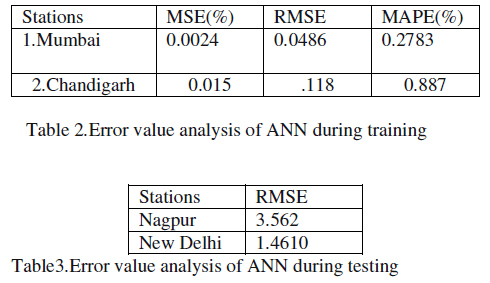 |
CONCLUSION |
| The use of Artificial Neural Network technique in modeling solar radiation, is reported and studied. The study indicates that selected ANN model has lower RMSE.The model is developed and proposed by including parameters like latitude, longitude, sunshine hours and height above sea level of different locations of India. A comparison of the proposed model with the measured data revealed that the predictions of solar radiation using the proposed model are in good agreement with the(Indian Meterological Department) IMD measured data. As such the model is developed, it is suitable for predicting solar radiation for locations in India for which solar radiation is required for site specific solar energy applications especially for solar power generation and production. |
References |
|